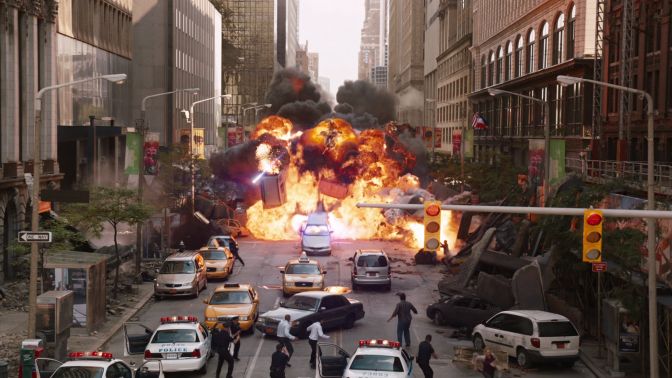Elements of Danger

Endangered innocent bystanders have long been a staple of comic book action. All those civilians caught in the middle of that alien invasion or smackdown between titans serve certain narrative functions. They help create a sense of danger, of empathy. They give villains a convenient way to distract the heroes. Who can forget this evil exchange?
General Zod said, “This ‘super-man’ is nothing of the kind; I’ve discovered his weakness.”
“Yes?” said Ursa.
“He cares. He actually cares for these Earth people.”
“Like pets?”
General Zod said, “I suppose.”
In big team battles against earth-beating threats, getting innocent bystanders out of the way also gives less powerful heroes something to do while the group’s heavy hitters tackle the main menace. For example, Thor and Hulk go toe-to-toe with the Leviathan while Black Widow and Captain America race to get the civilians to safety.
One way The Four Color Hack handles this sort of action is through the use of Elements. At their most basic level, Elements serve to grant advantage or impose disadvantage, depending on the narration of the action. Consider Cloud of Dust as an Element. A hero could use this Element to hide his movement, thus gaining advantage on an attempt to remain hidden. In a similar way, the Element could impose disadvantage on a hero’s energy blast since he can’t quite see his target.
A more serious Element, however, can have stats, pretty much as if it were a villain. Consider this example:
Huge and Fiery Explosion
Level 2 Element
Hit Points: 16 (2 Vigor)
Base Damage: 1d6
Powers: Collateral Damage d6
On this Element’s turn, the Editor should describe how someone is imminent peril. He then asks a hero, “What do you do?” The hero’s response to the peril is treated as defending against an attack from the Element. Should the hero fail, the Element’s damage (2d6) represents the level of harm the hero faces. Since hit points represent more than physical damage, proximity to the threat is not particularly important. The Element can be “fought” during a hero’s Panel, but the Element’s hit points are not its resistance to actual damage. Instead, they represent the level of danger to bystanders, buildings, et cetera. Once the Element has 0 hit points, it is no longer a threat.
Imagine a player running the fiery speedster Hot Flash in a scene like that shown in the picture above.
Editor: “The fireball expands with a roar and a blast of heat, lifting vehicles into the air. Hot Flash, you see a man behind the wheel of a truck, arms locked, mouth open in a scream, as his vehicle flies into the air. What do you do?”
Hot Flash: “Faster than the eye can see, I race forward, running up bits of debris as if they were stairs toward the cab of the truck, and then a smash through a window and out the driver side door, carrying the man to safety.”
Editor: “Excellent. Roll DEX with a +1.” (The +1 comes from the difference between the Element’s level and Hot Flash’s level, and it is a penalty in TFCH’s roll-low system.)
(A die clatters on the table.)
Editor: “Ooh. That’s a failure. You race up the bits of debris and smashes through the window to pull the man to safety, but not without being pelted with shards of street, glass, and other bits of shrapnel.” (More dice clatter.) “You take 9 points of damage. Your turn. What do you do now?”
Hot Flash: “After leaving the man in an alley, I race back, unconcerned with these minor cuts. I use my Fire Control to funnel the flame from the explosion up into the air where I hope it’ll dissipate harmlessly.”
Editor: “Clever. Roll INT with a +1.”
(Clatter, clatter!)
Hot Flash: “A one! Critical success!”
Editor: “Roll for double damage.” (Hot Flash scores 19 points of damage.) “Excellent! You’ve defeated the fireball. Narrate the results, please.”

Leave a Reply